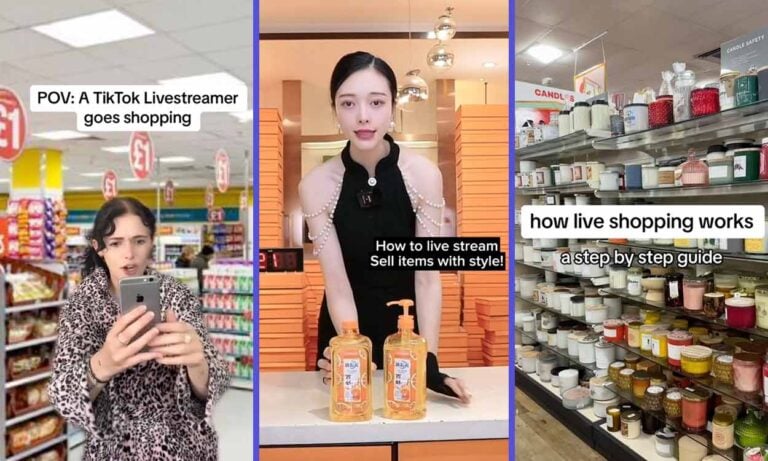What is livestream shopping and why do people (wrongly) think the trend is over before it even started?

Remember the days when your parents would tune in to the shopping network just to watch an overly animated white woman in a smart dress sell the most random products at lightning speed? Well, I do. As a child, I would eagerly tug at my parents’ arms as each new item appeared, watching the ‘in stock’ number steadily drop alongside the phone number blended into the screen. Back then, I was convinced that the purpose of watching was to buy, but now I understand that the unique pleasure of live shopping lies just as much in watching as it does in purchasing.
After years of ageing with its audience, live shopping eventually underwent a modern makeover in the shape of livestream shopping. Spearheaded by Chinese influencers, new Instagram and TikTok features, as well as new interactive shopping apps like Whatnot, the activity found a new home inside the phone screens of Gen Zers.
@live.shoping.douyin ♬ suara asli - live shoping douyin - live shoping douyin
However, with an economic downturn, a saturated market, and increased competition in the country where the trend originated, we can see the layout for a crisis that might make it over to the West. Here is everything you need to know about livestream shopping and why some people think the trend is over before it even really began.
What is livestream shopping?
Livestream shopping is when a brand or an influencer offers items for sale through livestreams on digital platforms. Simple enough, right? It is quite similar to the home shopping we are all familiar with, however, the added livestream element has turned it into an interactive experience, allowing users to ask questions and talk to the host during the livestream.
Remember all of the videos about people angrily going to work because they were too cool to dance on TikTok in 2019? It looks like the world of e-commerce trends gave them a second shot at their claim to quick money, internet stardom and fame with this emerging new industry.
@harriettlucyx I mean I can’t blame anyone but myself 🙄
♬ original sound - Char🤘🏻
@lucy.hnz ♬ original sound - Char🤘🏻
And all you have to do is smile and wave a few products into a camera for an audience that can’t get enough of it.
Live shopping shows are commonly hosted on social media platforms like Facebook and Instagram Live, TikTok Shop, specific apps, or e-commerce sites like Alibaba’s Taobao and Amazon.
@pinktag This is how we go live! #liveselling #livesells #pinktagstyle #switcher #boutiques #boutiquetips #goinglive #onair #bts #behindthescenes #selfielight #livesetup
♬ Chill Vibes - Tollan Kim
And I know what you’re thinking right now. Who has the time and the attention to stay on a livestream for the hours and hours these live shopping experiences can take? My attention span can barely hack a 90-second TikTok.
However, data collected by the livestream shopping app Whatnot shows that global consumers spend an average of over 80 minutes a day watching live shopping. Surprisingly, this figure isn’t far off from the approximate 200 minutes per day people spend watching content on Netflix. It shows that live shopping is as much a compelling form of entertainment as season seven of Love Is Blind.
“I observed the crazy success of Whatnot in the US, the sports trading card sector there had fast-paced shopping, social interaction, engaging content and crazy products that were being sold and wanted to get involved myself,” Adam Whittaker, also known as the Yorkshire Collector, said when SCREENSHOT asked how he got into the job. “I was approached and participated in somewhat similar live-streaming for a separate app for a short while, then as soon as Whatnot launched in the UK, they reached out and it was a no-brainer,” he recounted.
Whittaker quit his job as a pharmacist manager after making more money on Whatnot and selling over 2,500 items a month.
The shopstreaming trend originally started in China where nearly half of internet users had shopped on livestreams by mid-2023. Then, it quickly spread to the West, with a variety of new shopping apps and interactive shopping features on TikTok and Instagram popping up almost overnight. According to Whatnot, 70 per cent of Londoners are now livestream shoppers. The market is headed for 20 per cent of all global e-commerce by 2026.
What is the problem with livestream shopping then?
The trouble all started in China, where the trend has its roots. As the economy started to slow down, Chinese consumers decided to cut their spending and redirected themselves towards bargain deals. Unlike in 2022, when customers would fight to place orders whenever a product was listed on a livestreamer’s channel, they became increasingly picky.
With the competition ramping up, the market also became incredibly competitive and smaller streams and brands were forced out. As sales slumped, the companies that stayed in the game ramped up their employees’ workload, making livestream selling even more emotionally and physically draining than it was before.
Many workers and independent content creators started to report that they got lured into this profession by the boom but were unable to find access or proper footing in the industry once it had become ultra-competitive.
This crisis of livestream shopping hasn’t made it over the UK just yet. However, as the market is starting to pick up with brands like AliExpress launching livestream shopping channels, we can already see the features of livestream shopping woes.
For this reason, SCREENSHOT spoke with Ahmed Abdallah, a former livestream seller for a digital marketing company. When asked about his workload and the duration of the workday, he replied: “The work hours were indeed very long, and it could be emotionally draining, particularly during busy periods like Christmas or other holidays. It was especially challenging when only a few people were watching online, as maintaining high energy levels was crucial.”
“As a live streamer, the workload was generally manageable,” Abdallah recounted. “But it could feel repetitive at times. The most stressful moments occurred when putting in long hours without seeing significant returns, knowing that the process would repeat the next day.”
@wojiaoken New way to sell products... Show say price throw repeat! wojiaoken
♬ original sound - 我叫KEN - wojiaoken
The dream of making quick money by showcasing products in front of a camera persists in our capitalist society, which glorifies consumption and fosters an intense fixation on material possessions—it wouldn’t be an article by me if there wasn’t some sort of capitalist rant. However, behind livestream shopping’s facade of enjoyable and interactive consumption lies a world of relentless hustle and grind.
With livestream shopping on the rise, it’s easy to see an impending fall with stories from China of people who were lured in through the success of the market but then saw the bubble burst when it reached saturation and became too difficult to navigate. With streamers in the UK already voicing the demanding nature of the job, it poses the question: Where will this trend go?
Ultimately, its curb feels so predictable that it is almost boring, as it mirrors a historical pattern of opportunities that can swiftly transform into exploitation within the e-commerce sector. In five years, we will observe individuals expressing their frustrations that they were too cool to sell clothing or collectables online in 2024, while those who did act early benefit from their foresight, but are also vulnerable to being squeezed out by bigger creators and corporations and eventually collapse once the trend reaches full speed.





